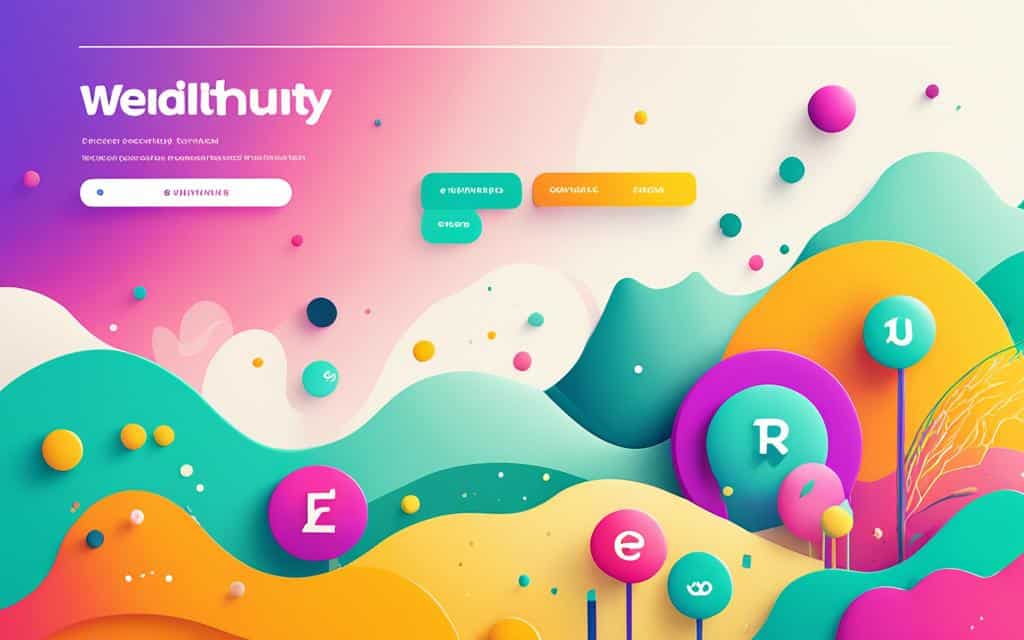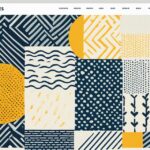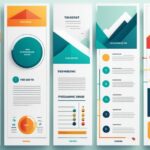Table of Contents
Emotional design is an innovative approach that utilizes graphics to influence the emotions of web users and enhance their overall online experiences. The objective is to connect with users on three cognitive levels – visceral, behavioral, and reflective – ultimately driving positive associations with products and brands. By evoking emotions, emotional design significantly impacts user experiences, fostering deeper connections between users and products. This, in turn, enhances user satisfaction, loyalty, and engagement.
Graphics play a pivotal role in emotional design. They have the power to evoke specific emotions and create a meaningful impact on users. By strategically implementing visuals, designers can craft interfaces that captivate users and elicit favorable emotional responses. These graphics, whether in the form of images, illustrations, or animations, contribute to the overall aesthetics and appeal of a website, making it more visually engaging and memorable.
Furthermore, emotional design helps differentiate products amidst a competitive web landscape. By evoking positive emotions, users are more likely to form lasting impressions and memories of a brand or product. This emotional connection plays a vital role in user perception, as it instills trust, familiarity, and affinity towards the offering.
Usability is another critical aspect of emotional design. When a website is visually appealing and easy to navigate, users experience a sense of satisfaction, which further reinforces positive emotions. Additionally, emotional design emphasizes functionality that caters to the specific needs and desires of users, adding value to their web experiences.
Content is equally essential in emotional design. It can be utilized to tell compelling stories that resonate with users’ emotions and create a sense of empathy. By crafting meaningful narratives, designers can establish a deeper connection with users, leaving a lasting impact on their overall experience.
Overall, emotional design is a powerful tool for web designers to create user-centric experiences that go beyond the functional attributes of a website. By skillfully leveraging graphics and evoking emotions, designers can cultivate positive user perceptions, enhance user satisfaction, and foster long-term loyalty.
The Importance of Emotional Design in UX
Emotions play a significant role in the user experience (UX) of digital products and services. Extensive research has demonstrated that emotions have a profound impact on user behavior, perception, and memory. By understanding and harnessing the power of emotions, designers can create impactful user experiences that resonate with their target audience.
In the world of UX design, emotions are not just fleeting reactions; they have a lasting impact on how users interact with and perceive a product or service. Positive emotional experiences can enhance user engagement, loyalty, and satisfaction, while negative emotions can lead to user abandonment and dissatisfaction.
To illustrate the importance of emotions in UX design, consider the following examples:
“When I visited an e-commerce website that had an appealing and user-friendly design, I felt a sense of excitement and trust. As a result, I ended up making a purchase and returning to the site for future shopping.” – Emma, a satisfied online shopper
“I once encountered a mobile app with a confusing and frustrating user interface. I felt overwhelmed and discouraged, which led me to uninstall the app and look for an alternative. The experience left a negative impression, and I was unlikely to give it a second chance.” – David, a disappointed user
The emotional impact of UX design goes beyond immediate user behavior. It also influences user perception and memory. When users have positive emotional connections with a digital product or service, they are more likely to remember it favorably and recommend it to others. User memory plays a crucial role in building customer loyalty and sustaining business success.
Emotional design focuses on intentionally creating products and services that elicit positive emotional responses from users. By integrating visual design elements, usability principles, functional features, and compelling content, designers can craft experiences that resonate with users on an emotional level.
| Emotions in UX Design | Impact on User Behavior | User Perception | User Memory |
|---|---|---|---|
| Positive emotions foster a sense of connection and engagement. | Users are more likely to take desired actions, such as making a purchase or sharing their experience. | The perception of a product or service is shaped by the emotional experience it provides. | Users remember experiences that evoke strong emotions, increasing brand recall and loyalty. |
| Negative emotions can lead to frustration, disengagement, and abandonment. | Users may leave a website or uninstall an app due to negative emotional experiences. | Negative emotions create a poor perception of a product or service, damaging the brand image. | Unpleasant emotional experiences are remembered and may deter users from returning or recommending. |
Understanding Emotional Design
Emotional design is a design approach that aims to create products and services that elicit positive emotional responses from users. It involves designing products that not only function well but also appeal to users on an emotional level. Key elements of emotional design include visual design, usability, functionality, and content.
Visual Design
Visual design plays a crucial role in emotional design as it impacts a user’s emotional response. Colors, typography, layout, and imagery are all components of visual design that can evoke specific emotions in users. For example, warm colors like red and yellow can convey excitement or passion, while cool colors like blue and green can evoke feelings of calmness or trust.
Usability
Usability is another important element of emotional design as it ensures ease of use and control. When users can easily navigate a website or interact with an app without frustrations or complications, it creates a positive emotional connection. Intuitive interfaces, clear navigation, and responsive feedback contribute to a seamless user experience and enhance emotional engagement.
Functionality
In emotional design, functionality focuses on meeting user needs and providing value. Products and services that solve real problems and deliver meaningful benefits have a higher chance of creating emotional connections with users. When users feel that a product or service understands their needs and improves their lives, it generates positive emotions and fosters a deeper emotional connection.
Content
Content is a powerful tool in emotional design as it can create emotional connections through storytelling and empathy. Well-crafted copy, compelling narratives, and user-centric messaging can evoke emotions and resonate with users on a personal level. By understanding their audience and using the right tone, language, and storytelling techniques, designers can create emotional connections that lead to stronger user engagement.
“Emotional design is about crafting experiences that engage users on a deeper, emotional level. It’s about creating products and services that not only fulfill functional needs but also evoke positive feelings and forge a lasting connection.”
Understanding the key elements of emotional design – visual design, usability, functionality, and content – is essential for creating products and services that elicit positive emotional responses from users. By designing with the user’s emotional experience in mind, designers can create more engaging and meaningful experiences that connect with users on a profound level.
Applying Emotional Design in Web Design
To apply emotional design in web design, designers must have a deep understanding of their users, which can be gained through user research. User testing and touch-point mapping are essential techniques that help identify pain points and frustrations that need to be addressed. By conducting user research, designers can uncover valuable insights into user behavior and preferences, allowing them to create web experiences tailored to their target audience.
User Research:
- By conducting user research, designers can gain insights into user preferences, motivations, and behaviors.
- Understanding the target audience enables designers to create designs that resonate with users on an emotional level.
- Through methods such as surveys, interviews, and observational studies, designers can gather valuable data to inform their design decisions.
- User research helps identify pain points and frustrations that users may encounter, allowing designers to address these issues and provide a seamless user experience.
Visual Design:
- Visual design plays a crucial role in emotional design, as it can evoke specific emotions and create a sense of personality and brand identity.
- Using colors, typography, layout, and imagery strategically can elicit emotional responses from users, enhancing their overall experience.
- Designers should consider the target audience and the emotions they want to evoke when crafting the visual design of a website.
- By aligning the visual design with the brand’s values and the desired emotional response, designers can create cohesive and impactful web experiences.
Usability and Functionality:
- Usability is paramount in emotional design, as users should find the website easy to navigate and interact with.
- Intuitive navigation, clear instructions, and thoughtful interactions contribute to a positive emotional experience for users.
- Functionality should focus on meeting user needs and providing value.
- Designers should ensure that essential features and functionalities are accessible and easy to use.
Content:
- Content plays a vital role in creating emotional connections with users.
- Through storytelling and empathetic messaging, designers can engage users’ emotions and establish a deeper connection.
- Well-crafted content that resonates with users can evoke positive emotions and create a lasting impact.
- Designers should carefully consider the tone, language, and narrative of the content to align it with the emotional design goals.
By applying emotional design principles in web design, designers can create engaging and effective web interfaces that leave a lasting impression on users. The convergence of user research, visual design, usability, functionality, and content enables designers to craft experiences that evoke the desired emotional responses and foster user engagement and satisfaction.
Conclusion
Emotional design is a fundamental aspect of user experience design that plays a crucial role in shaping the success of digital products and services. By understanding how emotions influence user experiences, designers can create engaging and memorable experiences that foster user loyalty and satisfaction.
When designers tap into the power of emotional design, they unlock the potential for increased user engagement. By appealing to users on an emotional level, products and services can create deep connections that go beyond functionality alone, resulting in a more meaningful user experience.
Additionally, emotional design has a direct impact on user loyalty. When users have positive emotional reactions to a product or service, they are more likely to develop brand loyalty and maintain long-term relationships. By designing for emotions, designers can create experiences that foster loyalty, ultimately leading to business success.
In a competitive digital landscape, user satisfaction is paramount. Emotional design significantly contributes to user satisfaction by creating experiences that resonate with users on an emotional level. When users feel connected, understood, and satisfied, they are more likely to continue using the product or service, promote it to others, and become loyal advocates.
FAQ
What is emotional design?
Emotional design is the practice of creating designs that evoke emotions in users, resulting in positive user experiences.
How does emotional design impact user experience?
Emotional design can significantly impact user experience by creating a deeper bond between users and products, making them more likely to have a positive experience and develop loyalty.
What are the benefits of emotional design?
Emotional design can make products more memorable, help differentiate them in a crowded market, increase motivation and engagement, contribute to user well-being, and enhance brand perception.
Why are emotions important in the user experience of digital products and services?
Emotions play a significant role in the user experience of digital products and services. Research has shown that emotions can impact user behavior, with positive emotional connections increasing the likelihood of purchase and negative emotions leading to abandonment.
What elements are involved in emotional design?
Key elements of emotional design include visual design, usability, functionality, and content.
How can emotional design be applied in web design?
To apply emotional design in web design, designers need to have a deep understanding of their users gained through user research. Visual design should create a sense of personality and brand identity, while usability ensures ease of use and control. Functionality should focus on meeting user needs and providing value, and content should tell stories and create empathy.
Why is emotional design important in user experience design?
Emotional design is an essential aspect of user experience design that should not be overlooked. By understanding the role of emotions in shaping user experiences and designing products and services that appeal to users on an emotional level, designers can create engaging, memorable, and successful user experiences.
How can emotional design lead to increased engagement, loyalty, and satisfaction?
Emotional design can lead to increased engagement, loyalty, and satisfaction by creating a deeper bond between users and products, making them more likely to have positive experiences and develop loyalty.













